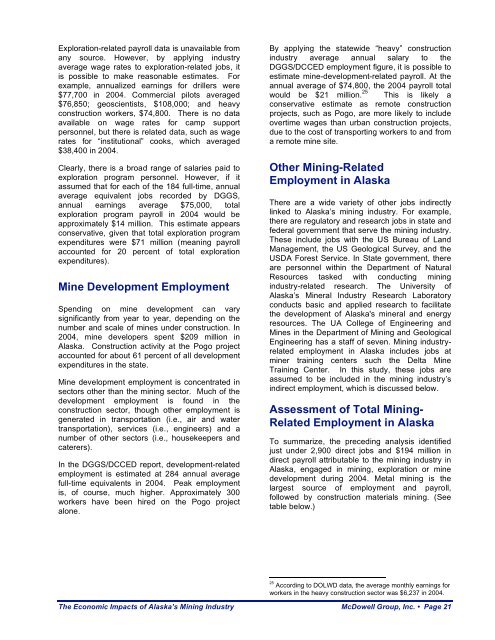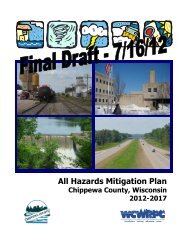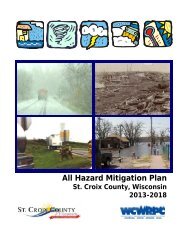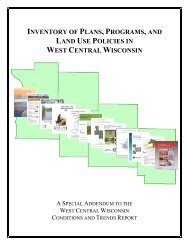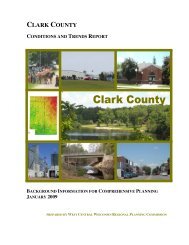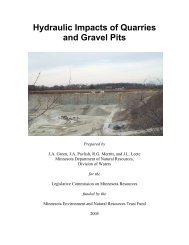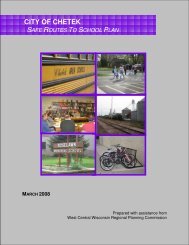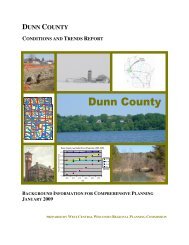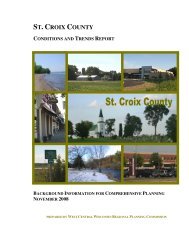The Economic Impacts of Alaska's Mining Industry - Alaska Miners ...
The Economic Impacts of Alaska's Mining Industry - Alaska Miners ...
The Economic Impacts of Alaska's Mining Industry - Alaska Miners ...
Create successful ePaper yourself
Turn your PDF publications into a flip-book with our unique Google optimized e-Paper software.
Exploration-related payroll data is unavailable from<br />
any source. However, by applying industry<br />
average wage rates to exploration-related jobs, it<br />
is possible to make reasonable estimates. For<br />
example, annualized earnings for drillers were<br />
$77,700 in 2004. Commercial pilots averaged<br />
$76,850; geoscientists, $108,000; and heavy<br />
construction workers, $74,800. <strong>The</strong>re is no data<br />
available on wage rates for camp support<br />
personnel, but there is related data, such as wage<br />
rates for “institutional” cooks, which averaged<br />
$38,400 in 2004.<br />
Clearly, there is a broad range <strong>of</strong> salaries paid to<br />
exploration program personnel. However, if it<br />
assumed that for each <strong>of</strong> the 184 full-time, annual<br />
average equivalent jobs recorded by DGGS,<br />
annual earnings average $75,000, total<br />
exploration program payroll in 2004 would be<br />
approximately $14 million. This estimate appears<br />
conservative, given that total exploration program<br />
expenditures were $71 million (meaning payroll<br />
accounted for 20 percent <strong>of</strong> total exploration<br />
expenditures).<br />
Mine Development Employment<br />
Spending on mine development can vary<br />
significantly from year to year, depending on the<br />
number and scale <strong>of</strong> mines under construction. In<br />
2004, mine developers spent $209 million in<br />
<strong>Alaska</strong>. Construction activity at the Pogo project<br />
accounted for about 61 percent <strong>of</strong> all development<br />
expenditures in the state.<br />
Mine development employment is concentrated in<br />
sectors other than the mining sector. Much <strong>of</strong> the<br />
development employment is found in the<br />
construction sector, though other employment is<br />
generated in transportation (i.e., air and water<br />
transportation), services (i.e., engineers) and a<br />
number <strong>of</strong> other sectors (i.e., housekeepers and<br />
caterers).<br />
In the DGGS/DCCED report, development-related<br />
employment is estimated at 284 annual average<br />
full-time equivalents in 2004. Peak employment<br />
is, <strong>of</strong> course, much higher. Approximately 300<br />
workers have been hired on the Pogo project<br />
alone.<br />
By applying the statewide “heavy” construction<br />
industry average annual salary to the<br />
DGGS/DCCED employment figure, it is possible to<br />
estimate mine-development-related payroll. At the<br />
annual average <strong>of</strong> $74,800, the 2004 payroll total<br />
would be $21 million. 25 This is likely a<br />
conservative estimate as remote construction<br />
projects, such as Pogo, are more likely to include<br />
overtime wages than urban construction projects,<br />
due to the cost <strong>of</strong> transporting workers to and from<br />
a remote mine site.<br />
Other <strong>Mining</strong>-Related<br />
Employment in <strong>Alaska</strong><br />
<strong>The</strong>re are a wide variety <strong>of</strong> other jobs indirectly<br />
linked to <strong>Alaska</strong>’s mining industry. For example,<br />
there are regulatory and research jobs in state and<br />
federal government that serve the mining industry.<br />
<strong>The</strong>se include jobs with the US Bureau <strong>of</strong> Land<br />
Management, the US Geological Survey, and the<br />
USDA Forest Service. In State government, there<br />
are personnel within the Department <strong>of</strong> Natural<br />
Resources tasked with conducting mining<br />
industry-related research. <strong>The</strong> University <strong>of</strong><br />
<strong>Alaska</strong>’s Mineral <strong>Industry</strong> Research Laboratory<br />
conducts basic and applied research to facilitate<br />
the development <strong>of</strong> <strong><strong>Alaska</strong>'s</strong> mineral and energy<br />
resources. <strong>The</strong> UA College <strong>of</strong> Engineering and<br />
Mines in the Department <strong>of</strong> <strong>Mining</strong> and Geological<br />
Engineering has a staff <strong>of</strong> seven. <strong>Mining</strong> industryrelated<br />
employment in <strong>Alaska</strong> includes jobs at<br />
miner training centers such the Delta Mine<br />
Training Center. In this study, these jobs are<br />
assumed to be included in the mining industry’s<br />
indirect employment, which is discussed below.<br />
Assessment <strong>of</strong> Total <strong>Mining</strong>-<br />
Related Employment in <strong>Alaska</strong><br />
To summarize, the preceding analysis identified<br />
just under 2,900 direct jobs and $194 million in<br />
direct payroll attributable to the mining industry in<br />
<strong>Alaska</strong>, engaged in mining, exploration or mine<br />
development during 2004. Metal mining is the<br />
largest source <strong>of</strong> employment and payroll,<br />
followed by construction materials mining. (See<br />
table below.)<br />
25<br />
According to DOLWD data, the average monthly earnings for<br />
workers in the heavy construction sector was $6,237 in 2004.<br />
<strong>The</strong> <strong>Economic</strong> <strong>Impacts</strong> <strong>of</strong> <strong>Alaska</strong>’s <strong>Mining</strong> <strong>Industry</strong> McDowell Group, Inc. • Page 21


